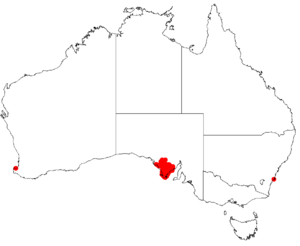Elm-seed hakea facts for kids
Quick facts for kids Elm-seed Hakea |
|
|---|---|
| Scientific classification | |
| Genus: |
Hakea
|
| Species: |
cycloptera
|
 |
|
| Occurrence data from Australasian Virtual Herbarium | |
The Hakea cycloptera, also known as the elm-seed hakea, is a special type of shrub. It belongs to the Proteaceae plant family. This plant is found only in South Australia, which means it is endemic there.
This small, spreading shrub is famous for its many pale pink or white flowers. These beautiful flowers bloom for a long time, from December all the way through August.
What Does It Look Like?
The Elm-seed Hakea grows as a bushy plant or shrub. It can be anywhere from about 1 to 4 feet (0.3 to 1.3 meters) tall. Its younger branches and new leaves are smooth and white.
The leaves are shaped like needles. They can be smooth or covered with soft, silky hairs. These leaves are usually about 2 to 6 inches (5 to 15 cm) long. They are very thin, about 0.04 to 0.07 inches (1.1 to 1.9 mm) wide. Each leaf ends in a sharp point, about 0.04 to 0.1 inches (1 to 2.8 mm) long.
Flowers and Fruit
The flowers of the Elm-seed Hakea grow in groups. Each group, called an inflorescence, has 1 to 14 white or pale pink flowers. They grow in clusters along the stem, like a flower spike.
The tiny stem that holds the flowers is very short, about 0.02 to 0.1 inches (0.5 to 3 mm) long. It has flat, white hairs. The individual flower stalks, called pedicels, are smooth. They are about 0.1 to 0.2 inches (2.5 to 6 mm) long.
The flower itself, called the perianth, can be pink or white. It measures about 0.1 to 0.2 inches (4 to 6.5 mm) long. It is smooth and has a bluish-green color with a powdery look. The style, which is part of the flower's reproductive system, is about 0.3 to 0.5 inches (7 to 12 mm) long.
After the flowers, the plant grows interesting fruits. These fruits are bumpy or wrinkled. They are broadly oval or round in shape. Each fruit is about 1 to 1.6 inches (2.5 to 4 cm) long and 0.8 to 1.3 inches (2 to 3.4 cm) wide. They end with a short, slanted, beak-like tip.
How It Got Its Name
The Elm-seed Hakea was officially named Hakea cycloptera by a botanist named Robert Brown. He named it in 1810. This name was then published in a scientific book called Transactions of the Linnean Society of London.
The second part of its scientific name, cycloptera, comes from two words in Ancient Greek.
- Kyklos means "circle."
- Pteron means "wing."
This name describes the shape of the seed's wing, which is round like a circle!
Where Does It Live?
The Elm-seed Hakea is only found in the Eyre Peninsula area of South Australia. It likes to grow in sandy soil. You can often find it in a type of bushland called mallee scrub.
This plant is quite tough! It can handle moderate frosts, which means it can survive when temperatures drop a bit below freezing. It's a useful and dense shrub, especially in dry areas. It also provides a good home for local wildlife.

